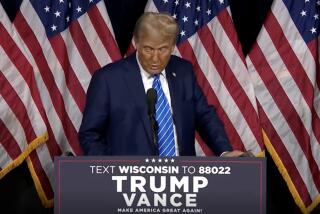Americans stick with health insurance despite Trump’s push to dismantle Obamacare
Americans kept up their health insurance last year despite President Trump’s all-out push to dismantle the Obama-era coverage expansion. That’s the counterintuitive conclusion from a major government survey released Tuesday.
After nearly a full year of Trump’s presidency, the uninsured rate was 9.1% for 2017, almost the same as toward the end of the Obama administration, according the Centers for Disease Control and Prevention. That works out to a little more than 29 million people uninsured.
Overall, the uninsured rate has dropped from 16% when the Affordable Care Act was signed in 2010, which translates roughly to 19 million people gaining coverage.
“Despite all the noise and despite the chain-rattling Republicans have done with their failed attempts at repeal, at the end of the day the number of uninsured has stayed flat,” said health economist Gail Wilensky, a longtime GOP advisor. “That’s good news for the country, and it might turn out to be good news for Republicans when it comes time for the midterm elections.”
But the CDC’s National Health Interview Survey also showed uninsured numbers edged up for some groups, raising questions about potential problems this year and beyond. It doesn’t reflect congressional repeal of the health law’s unpopular requirement that individuals carry health insurance, since that doesn’t take effect until next year.
Considered authoritative by experts, the CDC report contradicts popular story lines from both ends of the political spectrum. On the right, Trump and others have said Obamacare is “imploding.” (Instead, enrollment is fairly resilient.) On the left, Democrats blame Trump administration “sabotage” for coverage losses. (No hemorrhaging was found.)
“It’s a testament to the high value people place on health insurance,” said Katherine Hempstead, a senior health policy advisor at the nonpartisan Robert Wood Johnson Foundation. “People will tenaciously hang on to their health insurance.”
Still, the survey found some worrisome indicators of issues potentially ahead:
— The uninsured rate rose among “not poor” adults. (Translation: middle class.) That increase was statistically significant, rising to 8.2% in 2017. Hempstead said it may reflect the impact of sharp premium increases for individual plans for people in the solid middle class, who aren’t eligible for subsidized coverage under the ACA. “They are uniquely required to pay the full retail cost of healthcare,” she said.
— The uninsured rate also rose significantly in states that have not taken advantage of the ACA’s Medicaid expansion for low-income people. It averaged 19% for adults in states that had not expanded Medicaid, a big difference from about 9% uninsured in states that expanded low-income coverage. The Medicaid expansion survived repeal efforts, and several states are moving to join the 32 others, plus Washington, D.C., that have expanded.
Last year was tumultuous for healthcare, with Trump and Congress finally poised to deliver on the GOP vow to repeal President Obama’s signature law. After repeated tries, the effort collapsed in the Senate. But Republicans did manage to undo the law’s unpopular requirement that most Americans maintain coverage or risk fines. Many experts believe the number of uninsured Americans will increase when repeal of the “individual mandate” takes effect in 2019.
Trump also used his executive authority to undermine Obama’s law. He pulled the plug on legally contested subsidies for deductibles and copayments, triggering a leap in premiums. His administration cut the HealthCare.gov signup season in half and slashed the ad budget. Changes pending this year will allow insurers to offer lower-cost plans that have fewer benefits, and to turn away people in poor health.
Separately, the CDC survey showed no slowing of the longstanding shift to high-deductible health insurance, with nearly 44% of Americans now in plans that require individuals to pay at least the first $1,300 of medical bills each year, or $2,600 for family coverage.
Two independent private surveys have recently shown an increase the U.S. uninsured rate, but the CDC’s approach is different. The government survey relies on face-to-face interviews, not telephone polling. And it’s based on data from about 78,000 people — a very large pool.
“This report is as credible a data source on the uninsured as we have,” Wilensky said.
More to Read
Inside the business of entertainment
The Wide Shot brings you news, analysis and insights on everything from streaming wars to production — and what it all means for the future.
You may occasionally receive promotional content from the Los Angeles Times.










